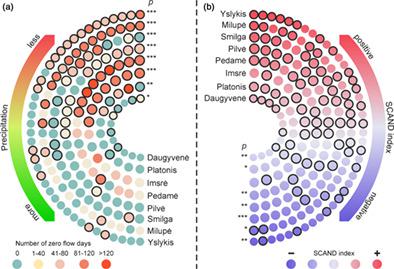当前位置:
X-MOL 学术
›
Hydrol. Process.
›
论文详情
Our official English website, www.x-mol.net, welcomes your feedback! (Note: you will need to create a separate account there.)
Impact of physico‐geographical factors and climate variability on flow intermittency in the rivers of water surplus zone
Hydrological Processes ( IF 3.2 ) Pub Date : 2020-09-20 , DOI: 10.1002/hyp.13912 Diana Šarauskienė 1 , Vytautas Akstinas 1 , Serhii Nazarenko 1 , Jūratė Kriaučiūnienė 1 , Aldona Jurgelėnaitė 1
Hydrological Processes ( IF 3.2 ) Pub Date : 2020-09-20 , DOI: 10.1002/hyp.13912 Diana Šarauskienė 1 , Vytautas Akstinas 1 , Serhii Nazarenko 1 , Jūratė Kriaučiūnienė 1 , Aldona Jurgelėnaitė 1
Affiliation

|
Climate change is inevitably altering the hydrological regime of water bodies. The interest in changing behaviour of intermittent rivers is increasing in many countries. This research was focused on intermittent rivers (rivers which naturally, periodically cease to flow) in Lithuania. The purpose of this research was to provide an overview of flow intermittency phenomena according to available data in a historical period and to evaluate the impact of catchment geographical features and climate variability on zero‐flow events. The calculated indices of flow intermittency showed that the selected rivers had very different flow regimes. The threshold for the separation of typically intermittent rivers from only occasionally intermittent ones was suggested. Multiple linear regression analysis defined the crucial role of catchment size and watercourse slope on the river cessation process in Lithuania. The applied non‐parametric Wilcoxon–Mann–Whitney test revealed the significance of the relationship between precipitation (in June–September) and zero‐flow duration. Flow intermittency phenomena in Lithuanian rivers were linked to a low‐frequency teleconnection pattern (SCAND index). A methodology of estimating the relation between river intermittency and large‐scale atmospheric circulation pattern (based on SCAND index) was created. The generated regression equations between flow intermittency indices and catchment characteristics might be useful for the estimation of zero‐flows in ungauged river catchments. The main aspect of future investigations might be related to forecasting flow intermittency using modern hydrological models and climate scenarios as well as the defined relationships between zero‐flow indices and physico‐geographical features of river catchments.
中文翻译:

物理地理因素和气候变化对富水区河流流动间歇性的影响
气候变化不可避免地改变了水体的水文状况。在许多国家,人们对改变间歇河的行为的兴趣正在增加。这项研究的重点是立陶宛的间歇性河流(自然会定期停止流动的河流)。本研究的目的是根据历史时期的可用数据概述流量间歇性现象,并评估流域地理特征和气候变化对零流量事件的影响。计算得出的水流间歇性指数表明,选定的河流具有不同的水流状态。提出了将典型间歇性河流与偶尔间歇性河流分开的阈值。多元线性回归分析确定了流域规模和河道坡度在立陶宛河流戒断过程中的关键作用。应用的非参数Wilcoxon–Mann–Whitney检验揭示了降水(6月至9月)与零流量持续时间之间关系的重要性。立陶宛河流的流动间歇现象与低频遥相关模式(SCAND指数)有关。建立了一种估算河流间歇性与大规模大气环流模式之间关系的方法(基于SCAND指数)。在流量间歇性指数和集水区特征之间生成的回归方程可能对估算未开河集水区的零流量很有用。
更新日期:2020-11-09
中文翻译:

物理地理因素和气候变化对富水区河流流动间歇性的影响
气候变化不可避免地改变了水体的水文状况。在许多国家,人们对改变间歇河的行为的兴趣正在增加。这项研究的重点是立陶宛的间歇性河流(自然会定期停止流动的河流)。本研究的目的是根据历史时期的可用数据概述流量间歇性现象,并评估流域地理特征和气候变化对零流量事件的影响。计算得出的水流间歇性指数表明,选定的河流具有不同的水流状态。提出了将典型间歇性河流与偶尔间歇性河流分开的阈值。多元线性回归分析确定了流域规模和河道坡度在立陶宛河流戒断过程中的关键作用。应用的非参数Wilcoxon–Mann–Whitney检验揭示了降水(6月至9月)与零流量持续时间之间关系的重要性。立陶宛河流的流动间歇现象与低频遥相关模式(SCAND指数)有关。建立了一种估算河流间歇性与大规模大气环流模式之间关系的方法(基于SCAND指数)。在流量间歇性指数和集水区特征之间生成的回归方程可能对估算未开河集水区的零流量很有用。


























 京公网安备 11010802027423号
京公网安备 11010802027423号